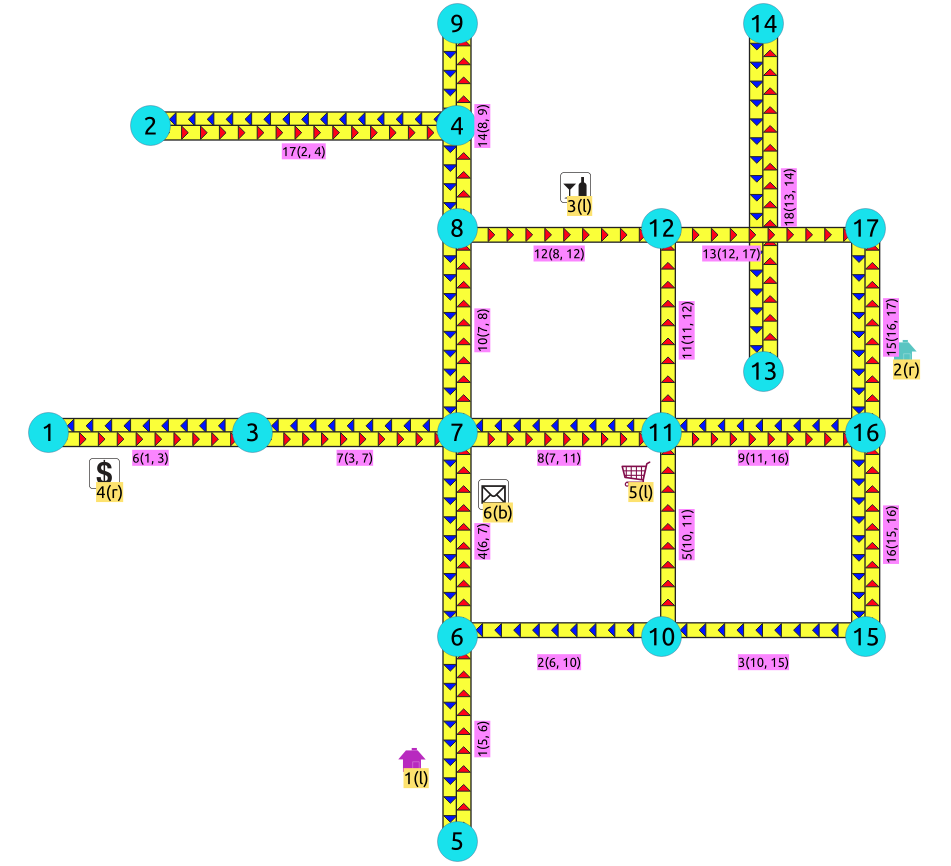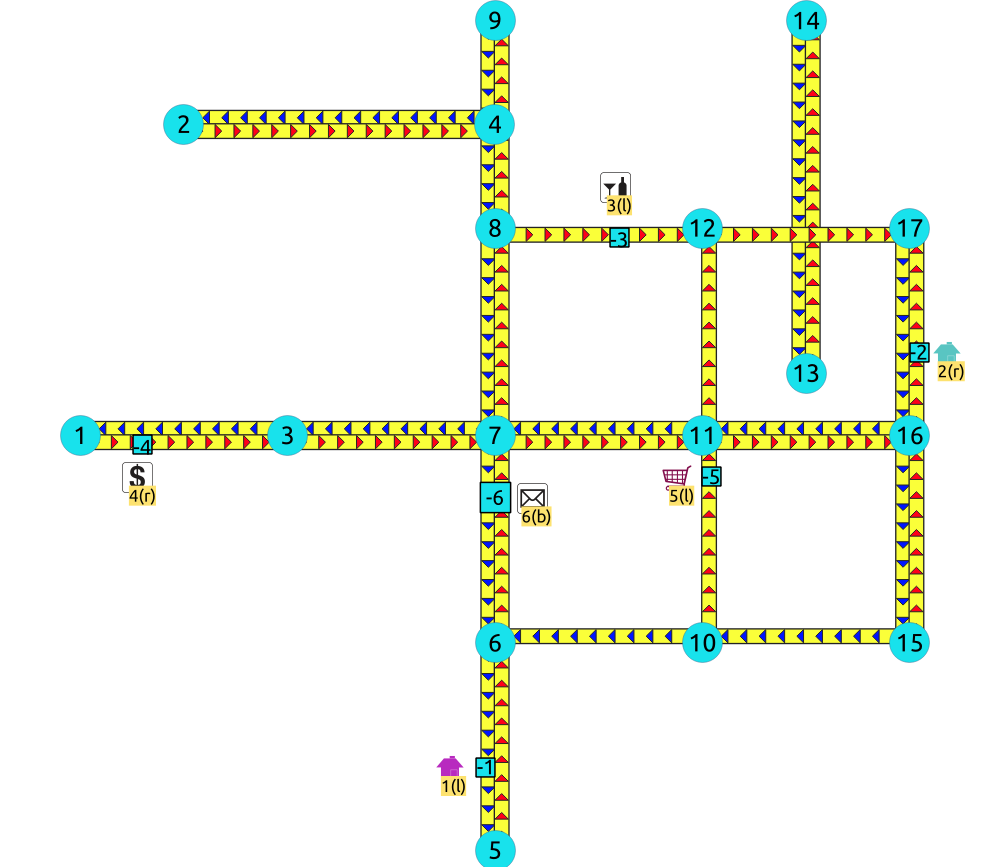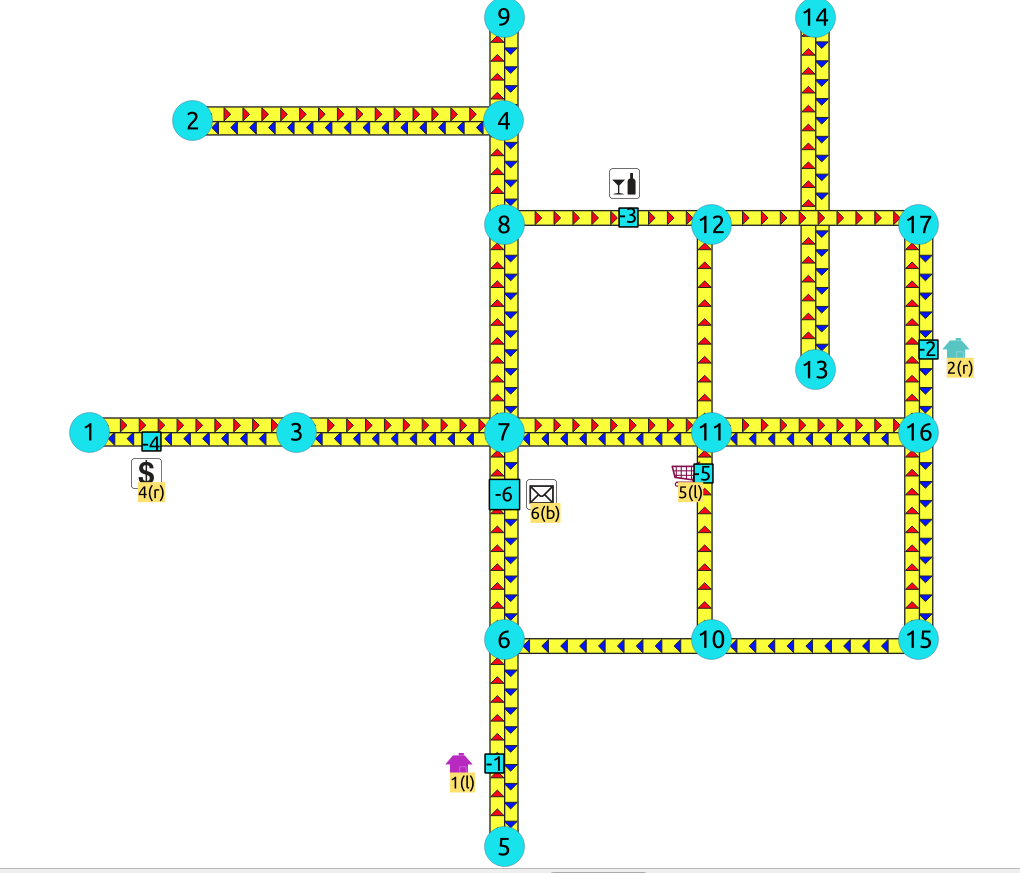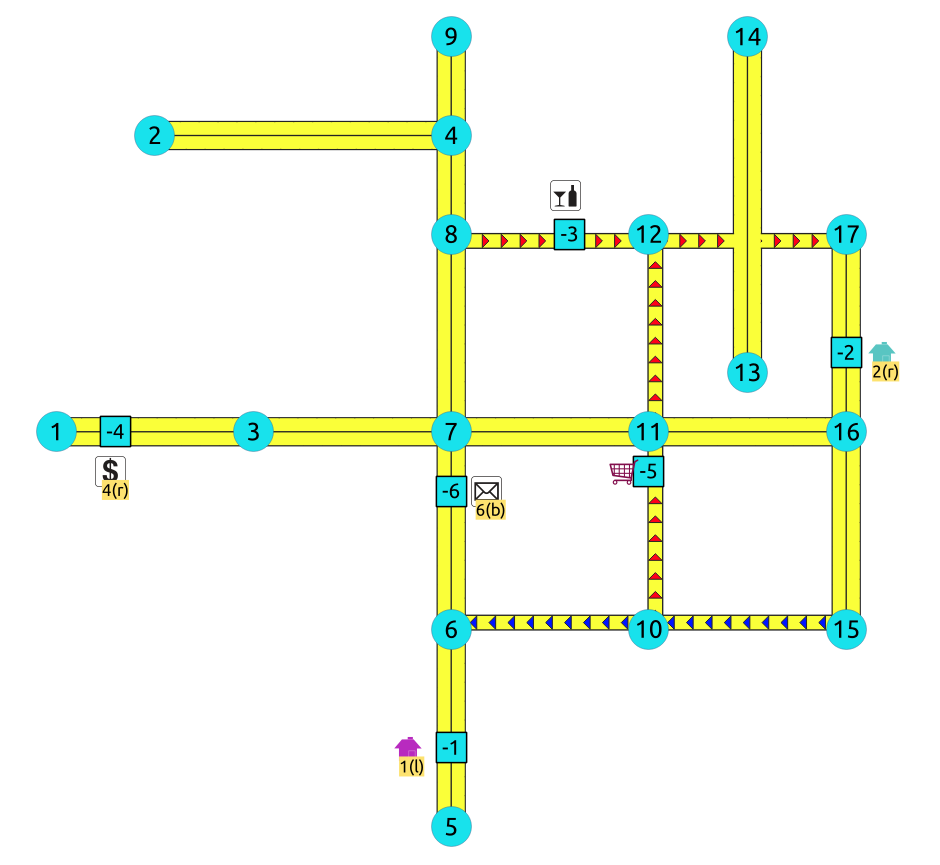withPoints- Categoría¶
Cuando los puntos se agregan al grafo.
Advertencia
Funciones propuestas para la próxima versión mayor.
No están oficialmente en la versión actual.
Es probable que oficialmente formen parte del próximo lanzamiento:
Las funciones hacen uso de ENTEROS y FLOTANTES
Probablemente el nombre no cambie. (Pero todavía puede)
Es posible que la firma no cambie. (Pero todavía puede)
Probablemente la funcionalidad no cambie. (Pero todavía puede)
Se han hecho pruebas con pgTap. Pero tal vez se necesiten más.
Es posible que la documentación necesite un refinamiento.
withPoints - Familia de funciones - Funciones basadas en el algoritmo Dijkstra.
Desde TRSP - Familia de funciones :
pgr_trsp_withPoints - Ruteo de Punto/Vértice con restricciones.
pgr_trspVia_withPoints - Ruteo Vía Punto/Vértice con restricciones.
Introducción¶
La categoría with points modifica el grafo continuamente al agregar puntos en las aristas, como es requerido por la consulta SQL de puntos .
Las funciones en esta categoría otorgan la habilidad de procesar entre puntos arbitrarios ubicados afuera del grafo original.
Esta categoría de funciones se origino para el ruteo de vehículos, pero bien puede funcionar si se aplica en algo que no incluya vehículos.
Cuando se da un identificador de punto pid que esta siendo mapeado a una arista con un identificador``edge_id``, con una fracción de la fuente al objetivo a lo largo de la arista fraction y existe información adicional sobre de que lado de la arista el punto está side, entonces el procesos desde puntos arbitrarios se puede hacer en redes fijas.
Todas estas funciones consideran el mayor numero características posibles del «mundo real»:
Tipo de grafo:
grafo dirigido
grafo no dirigido
Llegando al punto:
Llegada obligatoria en el lado del segmento donde se ubica el punto.
En cualquier lado del segmento.
Países con:
Manejando del lado derecho
Manejando del lado izquierdo
Algunos puntos son:
Permanente: por ejemplo el grupo de puntos de clientes guardados en una table en la base de datos.
El grafo fue modificado para que tenga esos puntos como vértices de manera permanente.
Hay una table en la base de datos que describe los puntos
Temporal: por ejemplo los puntos dados por una aplicación en la web
Usar pgr_findCloseEdges en el SQL de puntos.
La numeración de los puntos se marca con signo negativo.
El cambio de signo es para evitar confusión cuando hay un vértice con el mismo identificador de un identificador de punto.
Identificadores del punto original deben ser positivos.
Transformación a un negativo se hace internamente.
Interpretación del signo en la información del nodo en los resultados
signo positivo es un vértice en el grafo original
signo negativo es un punto en la SQL de puntos
Parámetros¶
Columna |
Tipo |
Descripción |
|---|---|---|
|
SQL de aristas como se describe a continuación |
|
|
SQL de puntos como se describe abajo |
|
|
SQL de combinaciones como se describe a abajo |
|
salida |
|
Identificador del vértice inicial de la ruta. Valor negativo es para identificador de punto. |
salidas |
|
Arreglo de identificadores de vértices iniciales. Valores negativos son para identificadores de puntos. |
destino |
|
Identificador del vértice final de la ruta. Valor negativo es para identificador de punto. |
destinos |
|
Arreglo de identificadores de vértices finales. Valores negativos son para identificadores de puntos. |
Parámetros opcionales¶
Parámetro |
Tipo |
x Defecto |
Descripción |
|---|---|---|---|
|
|
|
Valor en [
|
|
|
|
|
Consultas Internas¶
SQL aristas¶
Columna |
Tipo |
x Defecto |
Descripción |
|---|---|---|---|
|
ENTEROS |
Identificador de la arista. |
|
|
ENTEROS |
Identificador del primer vértice de la arista. |
|
|
ENTEROS |
Identificador del segundo vértice de la arista. |
|
|
FLOTANTES |
Peso de la arista ( |
|
|
FLOTANTES |
-1 |
Peso de la arista (
|
Donde:
- ENTEROS:
SMALLINT,INTEGER,BIGINT- FLOTANTES:
SMALLINT,INTEGER,BIGINT,REAL,FLOAT
SQL de puntos¶
Parámetro |
Tipo |
x Defecto |
Descripción |
|---|---|---|---|
|
ENTEROS |
valor |
Identificador del punto.
|
|
ENTEROS |
Identificador de la arista «más cercana» al punto. |
|
|
FLOTANTES |
El valor en <0,1> que indica la posición relativa desde el primer punto de la arista. |
|
|
|
|
Valor en [
|
Donde:
- ENTEROS:
SMALLINT,INTEGER,BIGINT- FLOTANTES:
SMALLINT,INTEGER,BIGINT,REAL,FLOAT
SQL Combinaciones¶
Parámetro |
Tipo |
Descripción |
|---|---|---|
|
ENTEROS |
Identificador del vértice de partida. |
|
ENTEROS |
Identificador del vértice de llegada. |
Donde:
- ENTEROS:
SMALLINT,INTEGER,BIGINT
Documentación avanzada¶
Sobre los puntos¶
For this section the following city (see Datos Muestra) some interesting points such as restaurant, supermarket, post office, etc. will be used as example.

El grafo es dirigido
Las flechas rojas muestran``(source, target)`` de la arista en al tabla de aristas
La flechas azules muestran
(target, source)la arista en la tabla de aristasCada ubicación de los puntos muestra su ubicación en relación con la arista
(source, target)A la derecha para los puntos 2 y 4.
A la izquierda para los puntos 1, 3 y**5**.
En ambos lados para el punto 6.
La representación de la base de datos sigue la descripción SQL de puntos , y para este ejemplo:
SELECT pid, edge_id, fraction, side FROM pointsOfInterest;
pid | edge_id | fraction | side
-----+---------+----------+------
1 | 1 | 0.4 | l
4 | 6 | 0.3 | r
3 | 12 | 0.6 | l
2 | 15 | 0.4 | r
5 | 5 | 0.8 | l
6 | 4 | 0.7 | b
(6 rows)
Lado de manejo¶
In the following images:
Los vértices cuadrados son vértices temporales,
Los vértices temporales se agregan según el lado de conducción,
visualmente mostrando las diferencias dependiendo de como se interpreta la información de lado de conducción.
Lado de manejo derecho¶

Punto**1** ubicado en la arista
(6, 5)Punto 2 ubicado en la arista``(16, 17)``
Punto 3 ubicado en la arista``(8, 12)``
Punto 4 ubicado en la arista``(1, 3)``
Punto 5 ubicado en la arista``(10, 11)``
Punto 6 ubicado en las aristas
(6, 7)y(7, 6)
Lado de manejo izquierdo¶

Punto**1** ubicado en la arista
(5, 6)Punto 2 ubicado en la arista``(17, 16)``
Punto 3 ubicado en la arista``(8, 12)``
Punto 4 ubicado en la arista``(3, 1)``
Punto 5 ubicado en la arista``(10, 11)``
Punto 6 ubicado en las aristas
(6, 7)y(7, 6)
Lado de manejo no importa¶
Como si se tuvieran todos los puntos en ambos lados considerados como
bPreferred usage on undirected graphs
En TRSP - Familia de funciones esta opción no es válida

Punto**1** ubicado en la arista``(5, 6)`` y
(6, 5)Punto 2 ubicado en la arista``(17, 16)`` y
(16, 17)Punto 3 ubicado en la arista``(8, 12)``
Point 4 located on edge
(3, 1)and(1, 3)Punto 5 ubicado en la arista``(10, 11)``
Punto 6 ubicado en las aristas
(6, 7)y(7, 6)
Creación de vértices temporales¶
This section will demonstrate how a temporary vertex is created internally on the graph.
Problem
For edge:
SELECT id, source, target, cost, reverse_cost
FROM edges WHERE id = 15;
id | source | target | cost | reverse_cost
----+--------+--------+------+--------------
15 | 16 | 17 | 1 | 1
(1 row)
insert point:
SELECT pid, edge_id, fraction, side
FROM pointsOfInterest WHERE pid = 2;
pid | edge_id | fraction | side
-----+---------+----------+------
2 | 15 | 0.4 | r
(1 row)
En una red de conducción del lado derecho¶
Lado de manejo derecho

Arrival to point
-2can be achieved only via vertex 16.Does not affects edge
(17, 16), therefore the edge is kept.Sólo afecta a la arista
(16, 17), por lo que la arista se elimina.Crear dos aristas nuevas:
Edge
(16, -2)with cost0.4(original cost * fraction ==Edge
(-2, 17)with cost0.6(the remaining cost)
The total cost of the additional edges is equal to the original cost.
If more points are on the same edge, the process is repeated recursevly.
En una red de conducción del lado izquierdo¶
Lado de manejo izquierdo

Arrival to point
-2can be achieved only via vertex 17.Does not affects edge
(16, 17), therefore the edge is kept.Sólo afecta a la arista
(17, 16), por lo que la arista se elimina.Crear dos aristas nuevas:
Work with the original edge
(16, 17)as the fraction is a fraction of the original:Edge
(16, -2)with cost0.4(original cost * fraction ==Edge
(-2, 17)with cost0.6(the remaining cost)If more points are on the same edge, the process is repeated recursevly.
Flip the Edges and add them to the graph:
Edge
(17, -2)becomes(-2, 16)with cost0.4and is added to the graph.Edge
(-2, 16)becomes(17, -2)with cost0.6and is added to the graph.
The total cost of the additional edges is equal to the original cost.
Cuando el lado de conducción no importa¶

Arrival to point
-2can be achieved via vertices 16 or 17.Afecta las aristas
(16, 17)y(17, 16)por lo que esas aristas se eliminan.Crear cuatro nuevas aristas:
Work with the original edge
(16, 17)as the fraction is a fraction of the original:Edge
(16, -2)with cost0.4(original cost * fraction ==Edge
(-2, 17)with cost0.6(the remaining cost)If more points are on the same edge, the process is repeated recursevly.
Flip the Edges and add all the edges to the graph:
Edge
(16, -2)is added to the graph.Edge
(-2, 17)is added to the graph.Edge
(16, -2)becomes(-2, 16)with cost0.4and is added to the graph.Edge
(-2, 17)becomes(17, -2)with cost0.6and is added to the graph.
Ver también¶
Índices y tablas